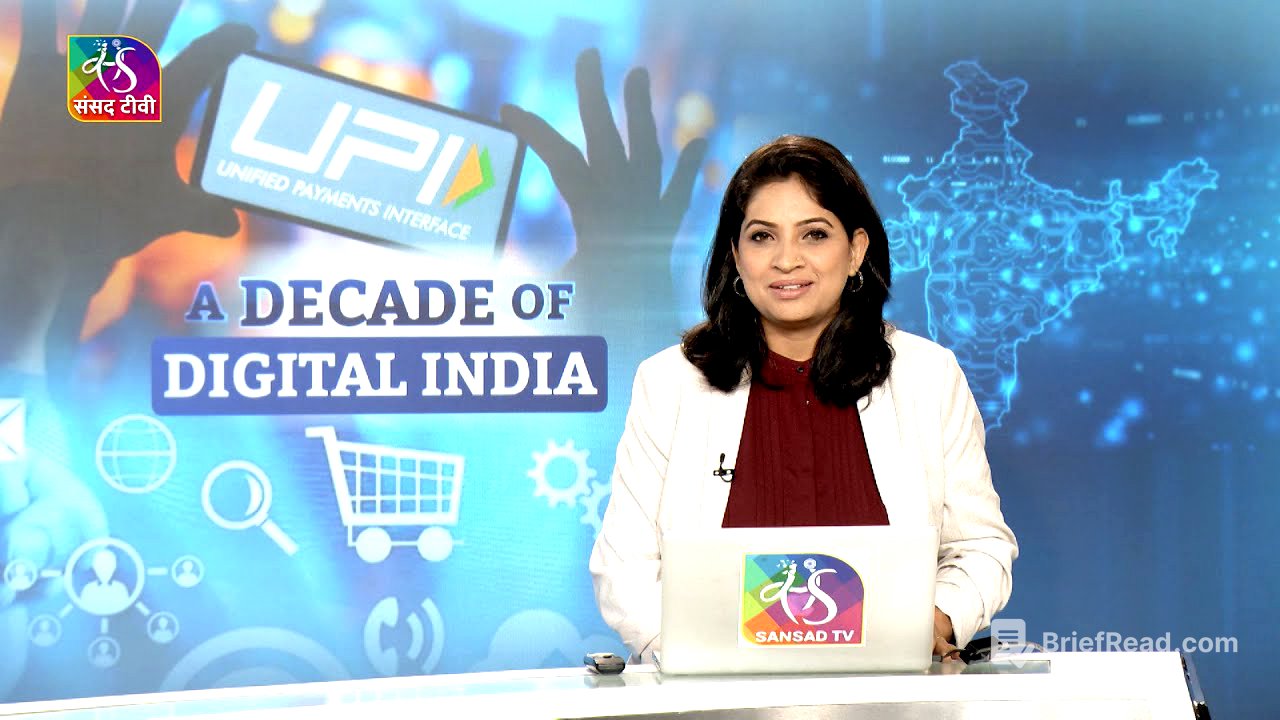TLDR;
This episode of Perspective on Sansad TV commemorates a decade of Digital India, launched in 2015, which has evolved into a nationwide movement impacting governance, economy, and society. The discussion highlights the program's inclusive nature, its role in global digital infrastructure, and its impact on citizen empowerment and economic transformation. Key points include:
- Digital India has become mainstream, benefiting all citizens, including those in remote areas.
- India's digital platforms are being studied and adopted globally.
- The program has fostered self-confidence and a new wave of entrepreneurship among Indian youth.
Introduction: A Decade of Digital India [0:00]
The host, Tina Ja, introduces the episode, highlighting the 10-year anniversary of Digital India. Launched in 2015, the initiative has transformed into a people's movement, reshaping how 1.4 billion Indians live, work, and connect. The episode aims to explore this transformational journey and the future of the digital revolution in India with guests Mr. Abhishek Singh and Mr. Shahed Sharma.
Game-Changing Aspects of Digital India [1:58]
Mr. Abhishek Singh identifies the most significant aspect of Digital India as its mainstream adoption and inclusivity. Projects like UPI are used by various segments of society, including street vendors and small businesses. Aadhaar has provided identity to everyone, ensuring financial inclusion, with 510 million Jan Dhan accounts opened and direct benefit transfers empowering people. Other initiatives like ONDC, which democratizes e-commerce, and DigiLocker, which enables paperless governance, are also contributing to India's digital transformation.
India's Digital Platforms: A Global Model [3:08]
Mr. Singh discusses how India's digital platforms, such as Aadhaar, Co-WIN, and DigiLocker, are being studied and adopted globally. These platforms have transformed governance, empowered people, and created value across sectors. Countries are looking at adopting Aadhaar through initiatives like MOSIP, and developed countries like France are adopting UPI. Brazil has also built a similar solution to UPI called Pix. Additionally, projects like Bhashini, which enables a language layer over services, are being considered by other countries.
India's Digital Transformation: A Turning Point [6:21]
Mr. Shahed Sharma emphasizes that Digital India marks a turning point, giving India self-confidence in achieving its goals. India accounts for over 50% of the world's digital transactions, including commerce and DBT transactions. This success is attributed to the "DPI sutras," a common thinking based on modularity, interoperability, and clearly outlined design principles. This unique approach has led to global interest and replication efforts in various countries.
Access, Inclusion, and Meaningful Participation [9:00]
Mr. Singh discusses the focus on inclusion within the Digital India program, ensuring access for those without smartphones or connectivity. 500,000 common service centers have been established across the country, providing assisted access. The focus is on building services in different languages, with projects like Bhashini enabling voice interface access. Projects like Lakhpati Didi empower self-help groups, and the Poshan Tracker digitizes nutrition data at Anganwadi centers.
Innovation and Direct Citizen Engagement [12:55]
Mr. Sharma notes that Digital India has ended the monopoly of middlemen, saving money and enabling participation on national platforms. He highlights the potential for MSME lending through cash flow lending and the success of pilots with GeM SAH. He also emphasizes the importance of public-private partnerships, citing UPI as an example where the government provides infrastructure and the private sector drives innovation. This model is also transforming the telecom equipment sector, fostering technology sovereignty and strategic autonomy.
Opportunities for Youngsters and Digital Skilling [17:14]
Mr. Singh explains how Digital India, along with initiatives like Startup India and ease of doing business, has created numerous opportunities for youngsters. Entrepreneurship has become a significant option, with funding support available through various government schemes. The opening up of sectors like defense and space research has further expanded opportunities. Digital India provides common infrastructure and platforms, allowing entrepreneurs to focus on innovation.
Collective Priorities for the Next Decade [21:39]
Mr. Singh emphasizes the importance of a "whole of India" approach, involving public, private, and not-for-profit sectors. This collaborative mindset has enabled faster and better progress. By continuing to take positive suggestions from all sectors, India can architect a more realistic and practical digital strategy.
From Digital Governance to Digital Leadership [24:13]
Mr. Sharma acknowledges the instrumental role of officers like Abhishek in breaking the mold and thinking in new ways. He highlights the collaboration across different ministries and departments, driven by a common vision. This approach allows India to aim for bigger things beyond digital, such as AI, quantum computing, and drones. He uses a sports analogy to illustrate how success in one area can inspire confidence and progress in others.
Message to Young Innovators and Safeguards [27:54]
Mr. Singh advises young innovators to avoid shortcuts, plan and architect systems well, and prioritize security. Compliance with regulations like the DPDP Act and building secure applications are crucial. He also emphasizes the need to address cybercrime, harassment, and misinformation. While promoting innovation, it is essential to restrict misuse and abuse of technology.









